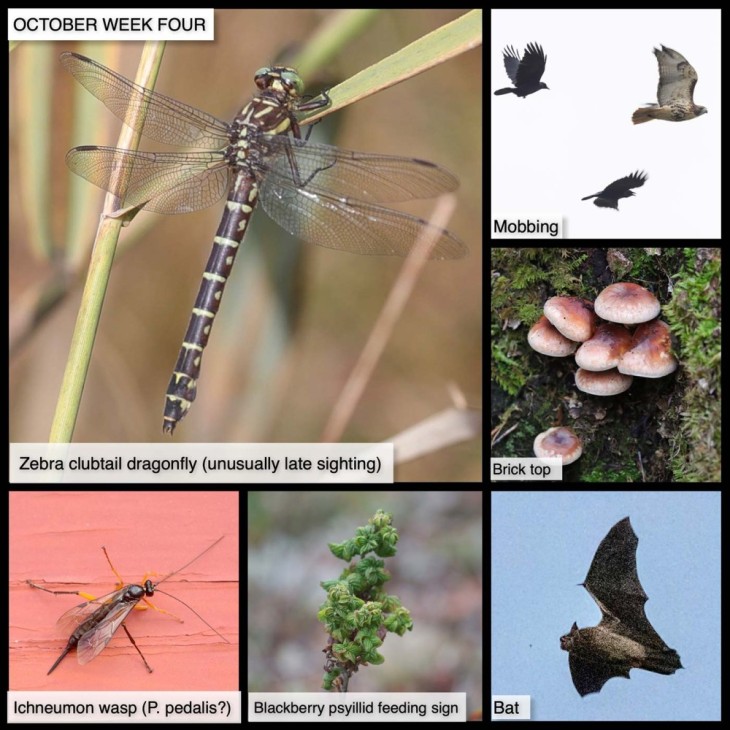This Week in the Woods, during a staff walk near our office, we discovered a large clubtail dragonfly that we later identified as a female zebra clubtail. One clue that you may be looking at a clubtail versus another large dragonfly such as a darner, is that clubtail eyes are spaced apart. According to the species profile in Dennis Paulson’s Dragonfies and Damselflies of the East, zebra clubtail females spend most of their lives up in the trees. And it’s really surprising to spot one of these dragonflies so late in the season. So this was a lucky find.
Here are some other nature sights this week (clockwise):
Several times this past week we have noticed American crows harrying owls and hawks (ravens are also common targets). As noted in this article from the Cornell Lab All About Birds site, mobbing is a tactic used by some birds to chase off predators or rivals for food and other resources. One of the reasons that mobbing works against predators is that it prevents the target from hunting effectively (it’s hard to take prey unaware when there are crows cawing at you and dive bombing your back). Photo courtesy of Tig Tillinghast.
We’ve been seeing a lot of brick top (brick cap) one of the latest growing autumn mushrooms, sprouting out of rotten hardwood. Here’s a profile from Michael Kuo’s Mushroom Expert blog. As noted in the National Audubon Society Field Guide to North American Mushrooms, people eat young brick tops, but the mushrooms become less palatable as they age.
With frost setting in and mosquitoes disappearing, we don’t expect to see many (or any) more bats this autumn, but a few were still chasing insects high above a campfire this past week. This is another courtesy image taken by Tig Tillinghast, long distance and in a low light – although it’s grainy, if you look carefully in the sky in front of the bat, you can just make out a speck that is its insect prey. Bat populations have dropped steeply due to white-nose syndrome, a fungal disease, so it’s great to see some in the sky. It’s hard to identify the species at this distance, but this is presumably a big brown or little brown bat. Here’s a fun profile of Vermont bat rehabilitationists Mo and Barry Genzlinger from our Summer 2016 magazine.
If you’re in a blackberry patch near conifers, keep an eye out for clumps of misshapen leaves. These are the work of tiny insects called blackberry psyllids (also known as bramble flea lice), which feed on the plants’ stems and leaves (adults) as well as sap (nymphs), disrupting normal growth patterns. In autumn, psyllids leave their blackberry hosts and overwinter on conifers. Here’s a post from Mary Holland’s Naturally Curious blog, which notes that the insects are also called “jumping lice.”
Finally, we found this female ichneumon wasp on the side of a barn, waggling her antennae in a way that suggested that she may have been seeking out prey vibrations. Ichneumon wasps are parasitoids – the females use their formidable ovipositors (what look like stingers) to inject eggs on or in living prey, which then become the host of the wasp larvae (and often get eaten from the inside out.) This appears to be a Pimpla pedalis, which preys on the larvae of several moths, including hemlock loopers and Lymantria dispar (formerly known as Gypsy moth).
Our thanks to The Bailey Charitable Foundation and the Frank and Brinna Sands Foundation for helping to support this series.
In this difficult period, many of us find joy in observing local nature. This series, launched in April 2020, shares nature photographs taken in the past seven days, or in the same week in 2020, most within 15 miles of the Northern Woodlands office in Lyme, New Hampshire. We hope you enjoy using this grid as a prompt for your own explorations.
What are you seeing in the woods this week? Share your images with us on Facebook, or submit a special photo for possible inclusion in our monthly online Reader Photo Gallery.


